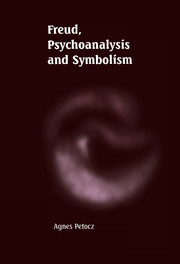Book contents
- Frontmatter
- Contents
- List of figures
- Preface
- Introduction
- Part One Exegesis and Extraction
- Part Two Consolidation and Defence
- 7 The problem of the ‘system unconscious’
- 8 The problem of language
- 9 Ernest Jones's contribution
- 10 The ‘Freudian Broad’ (FB) theory of symbolism
- 11 Symbolism: logical constraints and psychological requirements
- Epilogue
- List of references
- Index
11 - Symbolism: logical constraints and psychological requirements
Published online by Cambridge University Press: 22 October 2009
- Frontmatter
- Contents
- List of figures
- Preface
- Introduction
- Part One Exegesis and Extraction
- Part Two Consolidation and Defence
- 7 The problem of the ‘system unconscious’
- 8 The problem of language
- 9 Ernest Jones's contribution
- 10 The ‘Freudian Broad’ (FB) theory of symbolism
- 11 Symbolism: logical constraints and psychological requirements
- Epilogue
- List of references
- Index
Summary
The time has come to consider the question of evaluation: how does the FB theory fare in comparison with alternative approaches to symbolism? I mentioned in the introduction that, within psychology, psychoanalysis is caught between two opposing groups, each equally hostile to it, and each, ironically, locating it in the opposing movement. On one side, mainstream ‘experimental’ psychologists dismiss psychoanalysis as ‘unscientific’. On the other side, humanistic, phenomenological, existentialist and idealist psychologists reject classical psychoanalysis as ‘reductionist’ and ‘scientistic’. This latter group is part of a much larger movement in the social sciences generally, and it is there that the alternative material on symbolism is to be found. This material spans a number of different areas, each with its own claims on symbolism. In many general philosophical treatments, the question of ‘meaning’ is held to be the starting point of philosophy. Hermeneutics, the art or science of interpretation, also has ‘meaning’ as its central concept, and sees its task as ‘untangling the symbolic’. Semiotics, dealing with all signs and signifying systems, locates theories of symbolism within its boundaries. Aesthetics is concerned with the question of the ‘significance’ and the symbolic nature of art.
- Type
- Chapter
- Information
- Freud, Psychoanalysis and Symbolism , pp. 239 - 265Publisher: Cambridge University PressPrint publication year: 1999



